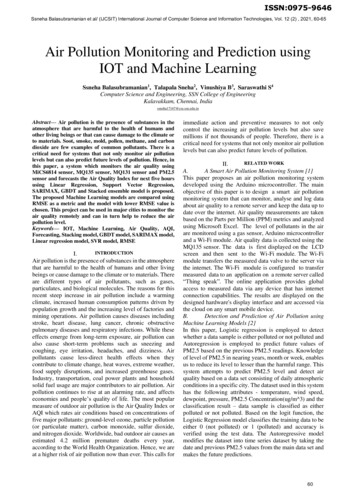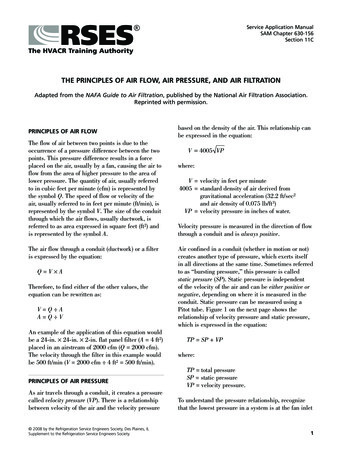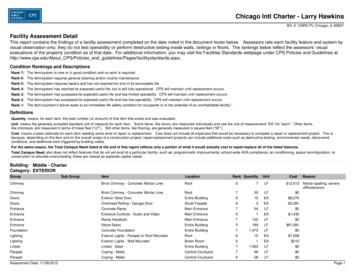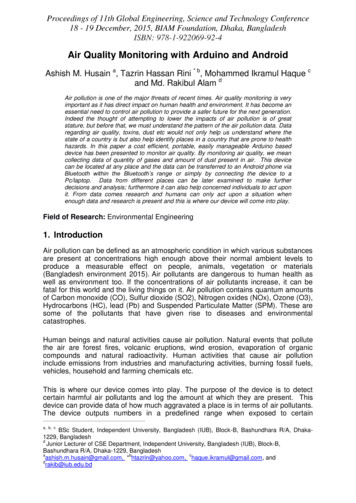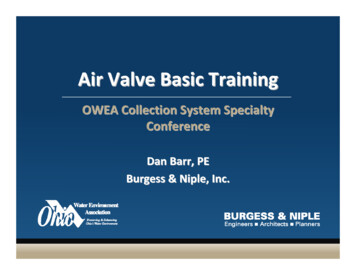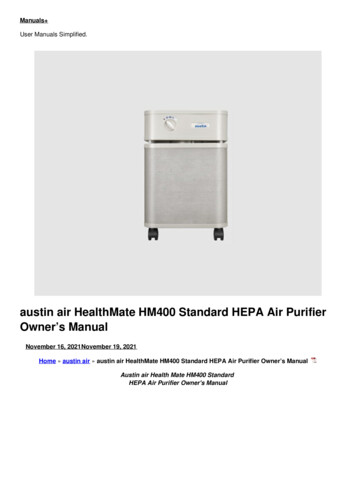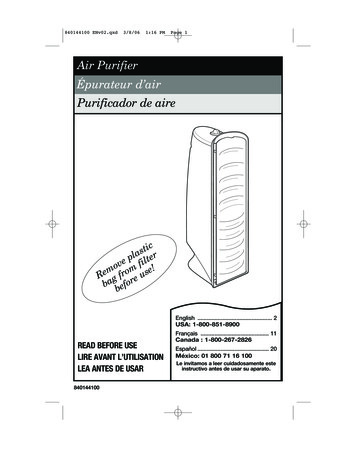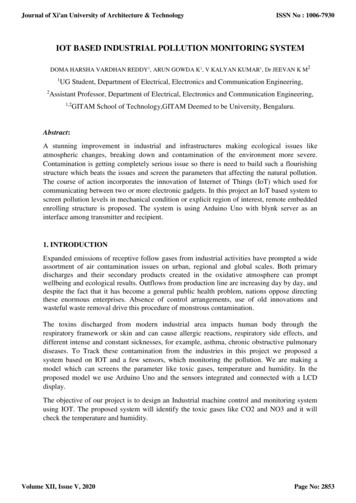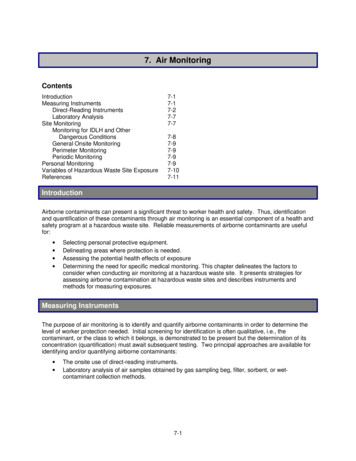
Transcription
7. Air MonitoringContentsIntroductionMeasuring InstrumentsDirect-Reading InstrumentsLaboratory AnalysisSite MonitoringMonitoring for IDLH and OtherDangerous ConditionsGeneral Onsite MonitoringPerimeter MonitoringPeriodic MonitoringPersonal MonitoringVariables of Hazardous Waste Site 107-11IntroductionAirborne contaminants can present a significant threat to worker health and safety. Thus, identificationand quantification of these contaminants through air monitoring is an essential component of a health andsafety program at a hazardous waste site. Reliable measurements of airborne contaminants are usefulfor: Selecting personal protective equipment.Delineating areas where protection is needed.Assessing the potential health effects of exposureDetermining the need for specific medical monitoring. This chapter delineates the factors toconsider when conducting air monitoring at a hazardous waste site. It presents strategies forassessing airborne contamination at hazardous waste sites and describes instruments andmethods for measuring exposures.Measuring InstrumentsThe purpose of air monitoring is to identify and quantify airborne contaminants in order to determine thelevel of worker protection needed. Initial screening for identification is often qualitative, i.e., thecontaminant, or the class to which it belongs, is demonstrated to be present but the determination of itsconcentration (quantification) must await subsequent testing. Two principal approaches are available foridentifying and/or quantifying airborne contaminants: The onsite use of direct-reading instruments.Laboratory analysis of air samples obtained by gas sampling beg, filter, sorbent, or wetcontaminant collection methods.7-1
Direct-Reading InstrumentsDirect-reading instruments were developed as early warning devices for use in industrial settings, wherea leak or an accident could release a high concentration of a known chemical into the ambientatmosphere. Today, some direct-reading instruments can detect contaminants in concentrations down toone part contaminant per million parts of air (ppm), although quantitative data are difficult to obtain whenmultiple contaminants are present. Unlike air sampling devices, which are used to collect samples forsubsequent analysis in a laboratory, direct reading instruments provide information at the time ofsampling, enabling rapid decision-making.Direct-reading instruments may be used to rapidly detect flammable or explosive atmospheres, oxygendeficiency, certain gases and vapors, and ionizing radiation. They are the primary tools of initial sitecharacterization. The information provided by direct-reading instruments can be used to instituteappropriate protective measures (e.g., personal protective equipment, evacuation), to determine the mostappropriate equipment for further monitoring, and to develop optimum sampling and analytical protocols.All direct-reading instruments have inherent constraints in their ability to detect hazards: They usually detect and/or measure only specific classes of chemicals.Generally, they are not designed to measure and/or detect airborne concentrations below 1 ppm.Many of the direct-reading instruments that have been designed to detect one particularsubstance also detect other substances (interference) and, consequently, may give falsereadings.It is imperative that direct-reading instruments be operated, and their data interpreted, by qualifiedindividuals who are thoroughly familiar with the particular device's operating principles and limitations andwho have obtained the device's latest operating instructions and calibration curves. At hazardous wastesites, where unknown and multiple contaminants are the rule rather than the exception, instrumentreadings should be interpreted conservatively. The following guidelines may facilitate accurate recordingand interpretation: Calibrate instruments according to the manufacturer's instructions before and after every use.Develop chemical response curves if these are not provided by the instrument manufacturer.Remember that the instrument's readings have limited value where contaminants are unknown.When recording readings of unknown contaminants, report them as "needle deflection" or"positive instrument response" rather than specific concentrations (i.e., ppm). Conduct additionalmonitoring at any location where a positive response occurs.A reading of zero should be reported as "no instrument response" rather than "clean" becausequantities of chemicals may be present that are not detectable by the instrument.The survey should be repeated with several detection systems to maximize the number ofchemicals detected.Tables 7-1 and 7-2 list several direct-reading instruments and the conditions and/or substances theymeasure. The flame ionization detector (FID) and the photoionization detector (PID) (see Table 7-1) arecommonly used at hazardous waste sites. However, some of these devices may not detect someparticularly toxic agents, including hydrogen cyanide and hydrogen sulfide. Thus, these devices must besupplemented with other methods of detection.7-2
Table 7-1. Some Direct-Reading Instruments for General SurveyINSTRUMENTCombustible GasIndicator (CGI)HAZARDMONITOREDCombustiblegases andvapors.APPLICATIONMeasures theconcentration of acombustible gasor vapor.DETECTIONMETHODA filament, usuallymade of platinum,is heated byburning thecombustible gasor vapor. Theincrease in heat ismeasured.LIMITATIONSAccuracy depends, inpart, on the differencebetween the calibrationand samplingtemperatures.EASE OFOPERATIONGENERAL CAREANDMAINTENANCEEffective userequires thatoperator understandthe operatingprinciples andprocedures.Recharge orreplace battery.Requires experienceto interpret datacorrectly, especiallyin the GC mode.Recharge orreplace battery.Calibrate immediately before use.Sensitivity is a functionof the differences inthe chemical andphysical propertiesbetween the calibrationgas and the gas beingsampled.TYPICALOPERATINGTIMESCan be usedfor as long asthe batterylasts, or for r isless.The filament can bedamaged by certaincom-pounds such assilicones, halides,tetraethyl lead, andoxygen-enrichedatmospheres.Does not provide avalid reading underoxygen-deficientconditions.Flame IonizationDetector (FID)with GasChromatographyOptionMany organicgases andvapors.In survey mode,detects the totalconcentration ofmany organicgases and vapors.In gas chromatography (GC)mode, identifiesand measuresspecificcompounds.Gases and vaporsare ionized in aflame. A currentis produced inproportion to thenumber of carbonatoms present.Does not detectinorganic gases andvapors, or somesynthetics. Sensitivitydepends on thecompound.Should not be used attemperatures less thanoo40 F (4 C).Difficult to absolutely7-3Specific identification requires calibration with thespecific analyte ofinterest.Monitor fuel and/orcombustion airsupply gauges.Perform routinemaintenance asdescribed in themanual.8 hours; 3hours with stripchart recorder.
DLIMITATIONSEASE OFOPERATIONidentify compounds.In survey mode,all the organiccom-pounds areionized anddetected at thesame time. In GCmode, volatilespecies are separated.GENERAL CAREANDMAINTENANCECheck for leaks.High concentrations ofcontaminants ofoxygen-deficientatmospheres requiresystem modification.In survey mode,readings can be onlyreported relative to thecalibration standardused.GammaRadiation on monitor.Scintillationdetector.Does not measurealpha or beta radiation.Extremely easy tooperate, but requiresexperience tointerpret data.Rugged, good infield use.Must be calibratedannually at aspecialized facilityPortable Infrared(IR) SpectrophotometerMany gasesand vapors.Measuresconcentration ofmany gases andvapors in air.Passes differentfrequencies of IRthrough thesample. The frequenciesadsorbed andspecific for eachcompound.In the field, must makerepeated passes toachieve reliableresults.Requires personnelwith extensiveexperience in IRspectrophotometry.As specified bymanufacturer.Designed toquantify one- res 115-volt ACpower.Not approved for usein a potentiallyflammable or explosiveatmosphere.Interference by watervapor and carbon7-4Can be usedfor as long asthe batterylasts, or for therecommendedintervalbetweencalibrationswhichever isless.
DLIMITATIONSEASE OFOPERATIONGENERAL tain vapors andhigh moisture mayattach the instrumentsoptics, which mustthen be replaced.Ultaviolet (UV)PhotoionizationDetector (PID)Many organicand someinorganicgases andvapors.Detects totalconcentrations ofmany organic andsome inor-ganicgases and vapors.Some identification ofcompounds ispossible if morethan one probe isused.Ionizes moleculesusing UVradiation;produces acurrent that ispropor-tional tothe number ofions.Does not detectmethane.Does not detect acompound if the probeused has a lowerenergy level than thecompound’s ionizationpotential.Response may changewhen gases are mixed.Other voltage sourcesmay interfere withmeasurements.Readings can only bereported relative to thecalibration standardused.Response is affectedby high humidity.7-5Effective userequires that theoperator understandthe operating principles and procedures, and be competent in calibrating,reading, andinterpreting theinstrument.Recharge orreplace battery.Regularly cleanlamp window.Regularly cleanand maintain theinstrument andaccessories.10 hours; 5hours with stripchart recorder.
Table 7-2. Some Direct-Reading Instruments for Specific r TubesHAZARDMONITOREDSpecificgases andvapors.APPLICATIONMeasuresconcentrations ofspecific gases andvapors.DETECTIONMETHODThe compoundreacts with theindicator chemicalin the tube,producing a stainwhose length orcolor change isproportional to thecompound’sconcentration.LIMITATIONSThe measuredconcentration of thesame compound mayvary among differentmanu-facturers’ tubes.Many similar chemicals interfere.EASE OFOPERATIONGENERAL CAREANDMAINTENANCEMinimal operatortraining andexpertise required.Do not use apreviously openedtube even if theindicator chemical isnot stained.Effective userequires that theoperatorunderstand theoperating principlesand procedures.Replace detectorcell according TIMESGreatest sources oferror are (1) how theoperator judges stain’send-point, and (2) thetube’s limitedaccuracy.Affected by humidity.Oxygen MeterOxygen (O2)Measures thepercentage of O2in air.Uses anelectrochemicalsensor to measurethe partialpressure of O2 inthe air and converts that readingto O2 concentration.Must be calibratedprior to use to compensate for altitudeand barometricpressure.Certain gases,especially oxidantssuch as ozone, canaffect read-ings.Carbon dioxide (CO2)poisons the detectorcell.7-6Recharge or replacebatteries prior toexpiration of thespecified interval.If the ambient air ismore than 0.5%CO2, replace the O2detector cellfrequently.8 to 12 hours.
Laboratory AnalysisDirect-reading personal monitors are available for only a few specific substances and are rarelysensitive enough to measure the minute (i.e., parts of contaminant per billion parts of air)quantities of contaminants which may, nevertheless induce health changes. Thus to detectrelatively low-level concentrations of contaminants, long-term or "full-shift" personal air samplesmust be analyzed in a laboratory. Full-shift air samples for some chemicals may be collected withpassive dosimeters, or by means of a pump which draws air through a filter or sorbent. Table 7-3lists some sampling and analytical techniques used at hazardous waste sites.Selection of the appropriate sampling media largely depends on the physical state of thecontaminants. For example, chemicals such as PCBs (polychlorinated biphenyls) and PNAs(polynuclear aromatic hydrocarbons) occur as both vapors and particulate-bound contaminants.A dual-media system is needed to measure both forms of these substances. The volatilecomponent is collected on a solid adsorbent and the nonvolatile component is collected on afilter. More than two dozen dual-media sampling techniques have been evaluated by NIOSH [l,2].A major disadvantage of long-term air monitoring is the time required to obtain data. The time lagbetween sampling and obtaining the analysis results may be a matter of hours, if an onsitelaboratory is available, or days, weeks, even months, if a remote laboratory is involved. This canbe significant problem if the situation requires immediate decisions concerning worker safety.Also, by the time samples are returned from a remote laboratory, the hazardous waste sitecleanup may have progressed to a different stage or to a location at which different contaminantsor different concentrations may exist. Careful planning and/or the use of a mobile laboratory onsite may alleviate these problems.Mobile laboratories may be brought on site to classify hazardous wastes for disposal. A mobilelaboratory is generally a trailer truck that houses analytical instruments capable of rapidlyclassifying contaminants by a variety of techniques. Typical instruments include gaschromatographs, spectrofluorometers, and infrared spectrophotometers. When not in use in themobile laboratory, these devices can be relocated to fixed-base facilities. Onsite laboratoryfacilities and practices should meet standards of good laboratory safety.Usually, a few of the field samples collected are analyzed on site to provide rapid estimates of theconcentration of airborne contaminants. These data can be used to determine the initial level ofworker personal protection necessary to modify field sampling procedures and to guide the fixedbase laboratory analysis. If necessary, samples screened in the mobile laboratory can besubsequently reanalyzed in sophisticated fixed-base laboratories. The mobile laboratory alsoprovides storage space, countertop staging areas for industrial hygiene equipment, and facilitiesfor recharging self-contained breathing apparatus.Site MonitoringPriorities for air monitoring should be based on the information gathered during initial sitecharacterization (see Chapter 6). This information serves as the basis for selecting theappropriate monitoring equipment and personal protective equipment (PPE) to use whenconducting site monitoring. Depending on site conditions and project goals, four categories ofsite monitoring may be necessary: monitoring for IDLH and other dangerous conditions, generalonsite monitoring, perimeter monitoring, and periodic monitoring.7-7
Table 7-3. Some Sample Collection and Analytical MethodsSUBSTANCECOLLECTION rideNitratePhosphateSulfatePrewashed silica geltubeIon chromatographyAliphatic esPCBsPesticidesSilica gelMCEFMCEFCharcoal tubeThermosorb/NMCEFGF filter and florisil tube13-mm GF filter andchromosorb 102 /MSTYPICAL DETECTIONLIMIT OF ANALYTICINSTRUMENT (λλg)105510201010100c0.5100.010.0010.05aMCEF mixed cellulose ester filter.GF glass fiber fillerbGC/NPD gas chromatography and nitrogen/phosphorus detector; PCM phase contrast microscopy; ICP-AES inductively coupled plasma atomic emission spectrometry; GM/MS gas chromatography and mass spectrometry;GC/TEA gass chromatography using a thermal energy analyzer; GC-ECD gas chromatography using an electricalconductivity detector.cUnits in fibers per mm2 of filter (Method No. 7400 from the NIOSH Manual of Analytical Methods, 3rd edition).Monitoring for IDLH and Other Dangerous ConditionsAs a first step, air monitoring should be conducted to identify any IDLH and other dangerousconditions, such as flammable or explosive atmospheres, oxygen-deficient environments, andhighly toxic levels of airborne contaminants. Direct-reading monitoring instruments will normallyinclude combustible gas indicators, oxygen meters, colorimetric indicator tubes, and organicvapor monitors. Other monitoring instruments may be necessary based on the initial sitecharacterization. When time permits, air samples should be collected for laboratory analysis.Extreme caution should be exercised in continuing a site survey when atmospheric hazards areindicated. Monitoring personnel should be aware that conditions can suddenly change fromnonhazardous to hazardous.Acutely hazardous concentrations of chemicals may persist in confined and low-lying spaces forlong periods of time. Look for any natural or artificial barriers, such as hills, tall buildings, ortanks, behind which air might be still, allowing concentrations to build up. Examine any confinedspaces such as cargo holds, mine shafts, silos, storage tanks, box cars, buildings, bulk tanks,and sumps where chemical exposures capable of causing acute health effects are likely toaccumulate. Low-lying areas, such as hollows and trenches, are also suspect. Monitor thesespaces for IDLH and other dangerous conditions. Also consider whether the suspectedcontaminants are lighter or heavier than air. Then, based on the type of contaminants present,consider sampling on hilltops, under any cover or canopy where workers might work orcongregate, and in trenches and low-lying areas.7-8
In open spaces, toxic materials tend to be emitted into the atmosphere, transported away fromthe source, and dispersed. Thus acutely hazardous conditions are not likely to persist in openspaces for extended periods of time unless there is a very large (and hence, readily identifiable)source, such as an overturned tankcar. Open spaces are therefore generally given a lowermonitoring priority.General Onsite MonitoringAir sampling should be conducted using a variety of media to identify the major classes ofairborne contaminants and their concentrations. The following sampling pattern can be used as aguideline. First, after visually identifying the sources of possible generation, collect air samplesdownwind from the designated source along the axis of the wind direction. Work upwind, untilreaching or getting as close as possible to the source. Level B protection (see Table 8-6 inChapter 8) should be worn during this initial sampling. Levels of protection for subsequentsampling should be based upon the results obtained and the potential for an unexpected releaseof chemicals.After reaching the source, or finding the highest concentration, sample cross-axis of the winddirection to determine the degree of dispersion. Smoke plumes, or plumes of instrumentdetectable airborne substances, may be released as an aid in this assessment. To ensure thatthere is no background interference and that the detected substance(s) are originating at theidentified source, also collect air samples upwind of the source.Perimeter MonitoringFixed-location monitoring at the "fenceline" or perimeter, where personal protective equipment isno longer required, measures contaminant migration away from the site and enables the SiteSafety Officer to evaluate the integrity of the site's clean areas. Since the fixed-location samplesmay reflect exposures either upwind or downwind from the site, wind speed and direction dataare needed to interpret the sample results.Periodic MonitoringSite conditions and thus atmospheric chemical conditions may change following the initialcharacterization. For this reason, monitoring should be repeated periodically, especially when: Work begins on a different portion of the site. Different contaminants are being handled. A markedly different type of operation is initiated (e.g., barrel opening as opposed toexploratory well drilling). Workers are handling leaking drums or working in areas with obvious liquidcontamination (e.g., a spill or lagoon).Personal MonitoringThe selective monitoring of high-risk workers, i.e., those who are closest to the source ofcontaminant generation, is highly recommended. This approach is based on the rationale thatthe probability of significant exposure varies directly with distance from the source. If workersclosest to the source are not significantly exposed, then all other workers are, presumably, alsonot significantly exposed and probably do not need to be monitored.7-9
Since occupational exposures are linked closely with active material handling, personal airsampling should not be necessary until site mitigation has begun. Personal monitoring samplesshould be collected in the breathing zone and, if workers are wearing respiratory protectiveequipment, outside the facepiece. These samples represent the actual inhalation exposure ofworkers who are not wearing respiratory protection and the potential exposure of workers whoare wearing respirators. It is best to use pumps that automatically maintain a constant flow rateto collect samples, since it is difficult to observe and adjust pumps while wearing gloves,respirators, and other personal protective equipment. Pumps should be protected withdisposable coverings, such as small plastic bags, to make decontamination procedures easier.Personal monitoring may require the use of a variety of sampling media. Unfortunately, singleworkers cannot carry multiple sampling media because of the added strain and because it is notusually possible to draw air through different sampling media using a single portable, batteryoperated pump. Consequently, several days may be required to measure the exposure of aspecific individual using each of the media [3, 4]. Alternatively, if workers are in teams, a differentmonitoring device can be assigned to each team member. Another method is to place multiplesampling devices on pieces of heavy equipment. While these are not personal samples, they canbe collected very close to the breathing zone of the heavy equipment operator and thus would bereasonably representative of personal exposure. These multimedia samples can yield as muchinformation as several personal samples [5].When considering employee monitoring, procedures and protocols found in OSHA's IndustrialHygiene Technical Manual may be useful [6].Variables of Hazardous Waste Site ExposureComplex, multi-substance environments such as those associated with hazardous waste sitespose significant challenges to accurately and safely assessing airborne contaminants. Severalindependent and uncontrollable variables, most notably temperature and weather conditions, canaffect airborne concentrations. These factors must be considered when developing an airmonitoring program and when analyzing data. Some demonstrated variables include: Temperature. An increase in temperature increases the vapor pressure of mostchemicals. Windspeed. An increase in wind speed can affect vapor concentrations near a freestanding liquid surface Dusts and particulate-bound contaminants are also affected. Rainfall. Water from rainfall can essentially cap or plug vapor emission routes from openor closed containers, saturated soil, or lagoons, thereby reducing airborne emissions ofcertain substances. Moisture. Dusts, including finely divided hazardous solids, are highly sensitive tomoisture content. This moisture content can vary significantly with respect to locationand time and can also affect the accuracy of many sampling results. Vapor emissions. The physical displacement of saturated vapors can produce shortterm, relatively high vapor concentrations. Continuing evaporation and/or diffusion mayproduce long-term low vapor concentrations and may involve large areas. Work activities. Work activities often require the mechanical disturbance of contaminatedmaterials, which may change the concentration and composition of airbornecontaminants.7-10
References1.Hill, R.H. and J.E. Arnold. 1979. A personal air sampler for pesticides. Arch. Environ.Contam. Toxicol. 8: 621-28.2.NIOSH. 1984. Manual of Analytical Methods, 4th ed. National Institute for OccupationalSafety and Health, Cincinnati, OH.3.Costello, R.J. 1983. U.S. Environmental Protection Agency Triangle Chemical Site, BridgeCity, Texas. NIOSH Health Hazard Evaluations Determination Report HETA 83-417-1357.pp. 6-7.4.Costello, R.J. and J. Melius. 1981. Technical Assistance Determination Report, ChemicalControl, Elizabeth, New Jersey, TA 80-77. National Institute for Occupational Safety andHealth, Cincinnati, OH. pp. 20-22.5.Costello, R.J.; B. Froenberg; and J. Melius. 1981. Health Hazard Evaluation DeterminationReport, Rollins Environmental Services, Baton Rouge, Louisiana, HE 81-37. NationalInstitute for Occupational Safety and Health, Cincinnati, OH.6.OSHA. March 30, 1984. Industrial Hygiene Technical Manual. OSHA Instruction CPL 22.20A.7-11
8. Personal Protective Equipment (PPE)ContentsIntroductionDeveloping a PPE ProgramProgram Review and EvaluationSelection of Respiratory EquipmentProtection FactorSelf-Contained Breathing Apparatus (SCBA)Supplied-Air Respirators (SARs)Combination SCBA/SARAir-Purifying RespiratorsSelection of Protective Clothing and AccessoriesSelection of Chemical-Protective Clothing (CPC)Permeation and DegradationHeat Transfer CharacteristicsOther ConsiderationsSpecial ConditionsSelection of EnsemblesLevel of ProtectionPPE UseTrainingWork Mission DurationPersonal Use FactorsDonning an EnsembleRespirator Fit TestingIn-Use MonitoringDoffing an EnsembleClothing ReuseInspectionStorageMaintenanceHeat Stress and Other Physiological FactorsMonitoringPreventionOther roductionAnyone entering a hazardous waste site must be protected against potential hazards. Thepurpose of personal protective clothing and equipment (PPE)1 is to shield or isolate individualsfrom the chemical, physical, and biologic hazards that may be encountered at a hazardous wastesite. Careful selection and use of adequate PPE should protect the respiratory system, skin,eyes, face, hands, feet, head, body, and hearing. This chapter describes the various types ofPPE that are appropriate for use at hazardous waste sites, and provides guidance in their1The term PPE is used in this manual to refer to both personal protective clothing and equipment.8-1
selection and use. The final section discusses heat stress and other key physiological factorsthat must be considered in connection with PPE use.Use of PPE is required by Occupational Safety and Health Administration (OSHA) regulations in29 CFR Part 1910 (see Table 8-1) and reinforced by U.S. Environmental Protection Agency(EPA) regulations in 40 CFR Part 300 which include requirements for all private contractorsworking on Superfund sites to conform to applicable OSHA provisions and any other federal orstate safety requirements deemed necessary by the lead agency overseeing the activities.No single combination of protective equipment and clothing is capable of protecting against allhazards. Thus PPE should be used in conjunction with other protective methods. The use ofPPE can itself create significant worker hazards, such as heat stress, physical and psychologicalstress, and impaired vision, mobility, and communication. In general, the greater the level of PPEprotection, the greater are the associated risks. For any given situation, equipment and clothingshould be selected that provide an adequate level of protection. Over-protection as well asunder-protection can be hazardous and should be avoided.Developing a PPE ProgramA written PPE program should be established for work at all hazardous waste sites. (OSHArequires a written program for selection and use of respirators 129 CFR Part 1910.1341). Someof the relevant regulations, listed in Table 8-1, are cited throughout the text. The word "shall" isused only when the procedure is mandated by law.The two basic objectives of any PPE program should be to protect the wearer from safety andhealth hazards, and to prevent injury to the wearer from incorrect use and/or malfunction of thePPE. To accomplish these goals, a comprehensive PPE program should include hazardidentification; medical monitoring; environmental surveillance; selection, use, maintenance, anddecontamination of PPE; and training. These subjects are discussed in this chapter and inChapters 2, 4, 5, 6, 7, and 10.The written PPE program should include policy statements, procedures, and guidelines. Copiesshould be made available to all employees, and a reference copy should be available at eachwork site. Technical data on equipment, maintenance manuals, relevant regulations, and otheressential information should also be made available.Program Review and EvaluationThe PPE program should be reviewed at least annually. Elements which should be considered inthe review include: A survey of each site to ensure compliance with regulations applicable to the specific siteinvolved.The number of person-hours that workers wear various protective ensembles.Accident and illness experience.Levels of exposure.Adequacy of equipment selection.Adequacy of the operational guidelines.Adequacy of decontamination, cleaning, inspection, maintenance, and storage programs.Adequacy and effectiveness of training and fitting programs.Coordination with overall safety and health program elements.The degree of fulfillment of program objectives.8-2
The adequacy of program records.Recommendations for program improvement and modification.Program costs.The results of the program evaluation should be made available to employees and presented totop management so that program adaptations may be implemented.Table 8-1. OSHA Standards for Use of PPETYPE OF PROTECTIONREGULATIONSOURCEGeneral29 CFR Part 1910.13241 CFR Part 50-204.7 General Requirements forPersonal Protective Equipment29 CFR
assessing airborne contamination at hazardous waste sites and describes instruments and methods for measuring exposures. Measuring Instruments The purpose of air monitoring is to identify and quantify airborne contaminants in order to determine the level of worker protection needed. Initial screening for identification is often qualitative , i .


